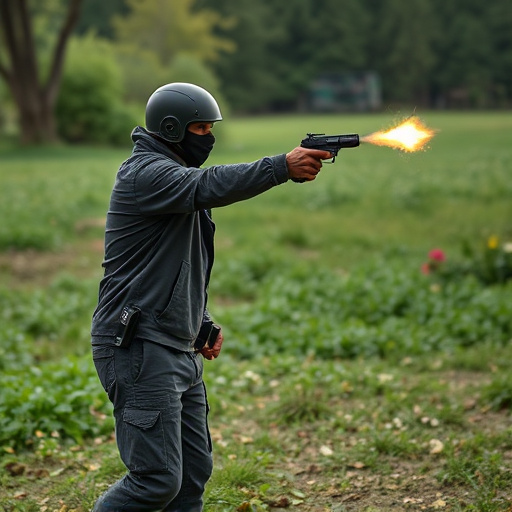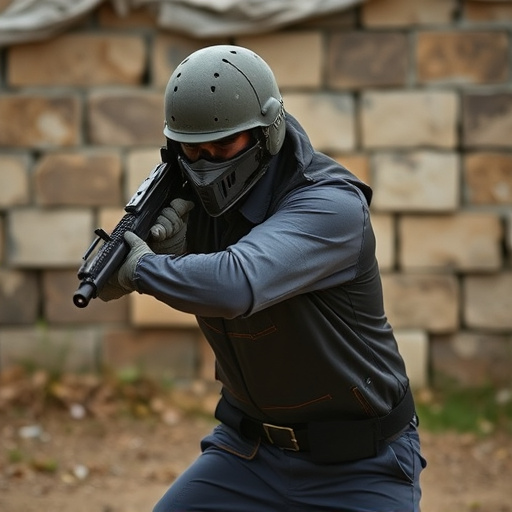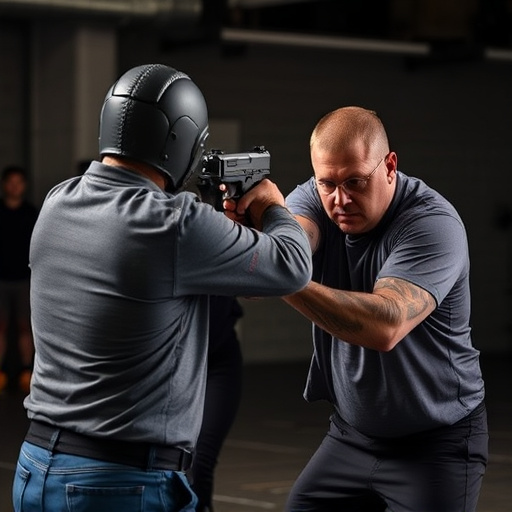The neuromuscular effects of stun devices, caused by electric currents overwhelming motor neurons, lead to temporary paralysis and muscle contractions, resulting in incapacitation. Stun guns utilize these effects for safe yet powerful restraint to enable escape or summoning help. Key safety features like activation switches prevent accidental deployments, enhancing user control. Best practices, proper training, and legal regulations mitigate risks associated with these devices' unique physiological impacts. Advanced technology incorporates sophisticated sensors and mechanisms to ensure controlled use while prioritizing personal safety.
Discover the essential role of activation safety switches in stun guns, a critical component ensuring user safety. This article delves into the mechanics behind these devices, exploring how they induce neuromuscular disruption as a non-lethal force. We examine the evolution of safety features, including best practices for responsible use, legal frameworks governing their design and distribution, and future prospects to enhance stun device safety further. By understanding the neuromuscular effects, users can navigate potential risks with confidence, empowering them with knowledge in high-pressure situations.
- Understanding Neuromuscular Disruption: How Stun Devices Work
- The Role of the Activation Safety Switch in Stun Guns
- Ensuring User Safety: Precautions and Best Practices
- Legal Considerations and Regulations for Stun Device Safety Switches
- Future Innovations: Enhancing Safety Features in Stun Devices
Understanding Neuromuscular Disruption: How Stun Devices Work

The neuromuscular effects of stun devices are a critical aspect to understand when considering their safety and effectiveness. These devices operate by disrupting the electrical signals that control muscle movement in the body, specifically targeting the nervous system. When activated, a stun gun delivers an electric current that overloads the motor neurons, temporarily paralyzing them. This neuromuscular disruption causes the targeted muscles to contract involuntarily, leading to the characteristic stiffening and falling that occurs upon stun activation.
The intensity of this effect varies depending on the device’s design and the specific electrical current delivered. Modern stun guns are engineered to cause a safe but powerful enough response to incapacitate an attacker temporarily, allowing for escape or the opportunity to summon help. By understanding how these devices work on a neuromuscular level, users can better appreciate their capabilities and ensure responsible usage.
The Role of the Activation Safety Switch in Stun Guns

The activation safety switch in stun guns plays a critical role in ensuring user control and minimizing unintended deployment. This safety mechanism is designed to prevent accidental activation, which could lead to unwanted neuromuscular effects of stun devices. By requiring a deliberate action to turn on the device, users can activate the stun gun only when needed, enhancing safety during encounters.
The switch typically involves a simple yet reliable design that requires pressure or a specific motion to trigger. This direct interaction gives users precision in their response time and allows for controlled use of force. Understanding the functionality of this safety switch is essential for anyone considering carrying a stun gun as a personal defense mechanism, ensuring both effectiveness against potential threats and responsible handling.
Ensuring User Safety: Precautions and Best Practices

Ensuring user safety is paramount when handling and deploying a stun gun. To mitigate risks associated with the neuromuscular effects of stun devices, users must adhere to best practices. These include always aiming for non-vital areas, such as the thigh or shoulder, to minimize the impact on vital organs. Additionally, only activate the device when necessary and in self-defense situations, avoiding excessive use which could lead to accidental injuries or prolonged immobilization.
Training is crucial in understanding the appropriate usage and range of a stun gun. Users should be familiar with the device’s safety switches, activation mechanisms, and deactivation procedures. Practicing realistic scenarios can help individuals develop muscle memory for safe and effective deployment. Regular maintenance and inspection of the stun gun are also essential to ensure reliable operation, including checking battery life and ensuring the device is in good working condition.
Legal Considerations and Regulations for Stun Device Safety Switches

The legal landscape surrounding stun devices, including their safety switches, is intricate and varies significantly across jurisdictions. These regulations are designed to balance personal safety with public safety concerns. Key considerations often include the definition of a stun device, its power output, and restrictions on who can possess and use such devices. In many regions, stun guns are categorized as less-lethal weapons, differentiated from deadly force by their neuromuscular effects rather than permanent physical damage. This classification influences both the legal status and safety standards applied to these devices.
Regulations may mandate specific safety features for stun device activation switches, such as lockouts to prevent accidental discharge or requirement for a conscious trigger pull. Compliance with these regulations is crucial for manufacturers and users alike, ensuring that stun devices function as intended while minimizing risks. Understanding local laws and adhering to industry standards are essential steps in promoting responsible use and mitigating potential adverse neuromuscular effects associated with stun device deployment.
Future Innovations: Enhancing Safety Features in Stun Devices

As technology advances, the development of stun devices is evolving to incorporate enhanced safety features. One area of focus is the integration of sophisticated sensors and activation mechanisms that respond to specific neuromuscular effects. By understanding the unique physiological reactions induced by stun devices, engineers can design safety switches that trigger only when necessary, minimizing accidental discharges and enhancing user control.
Future innovations may include sensitive pressure or impact sensors that detect the force applied during a struggle, activating the stun gun only when a certain level of resistance is met. This ensures that the device remains safe in everyday carry scenarios while providing effective protection when needed, thereby balancing the delicate equilibrium between personal safety and responsible use.
The stun gun activation safety switch plays a pivotal role in ensuring user safety and responsible usage. By understanding the neuromuscular disruption caused by stun devices, we can appreciate the importance of these safety mechanisms. Precautions and legal considerations further emphasize the need for robust safety switches to prevent misuse and protect both users and bystanders. As technology advances, future innovations in stun device safety features hold promise for enhanced user protection, ensuring that these powerful tools are employed responsibly and effectively.
